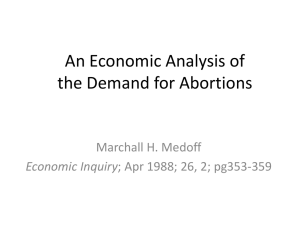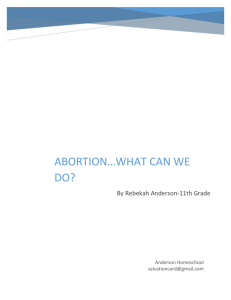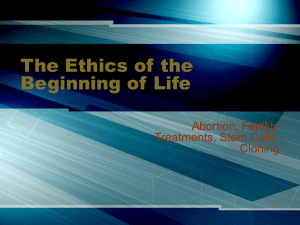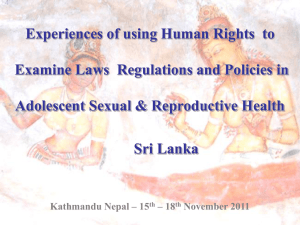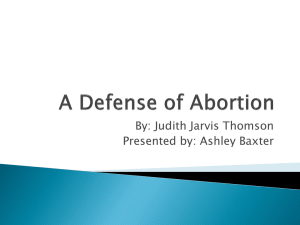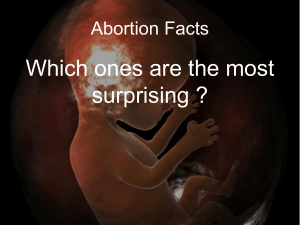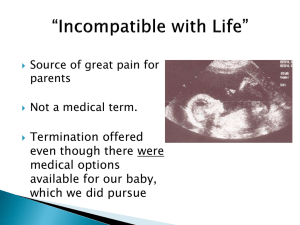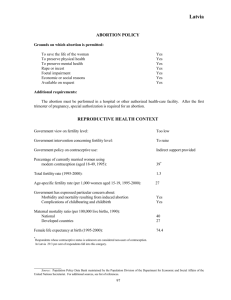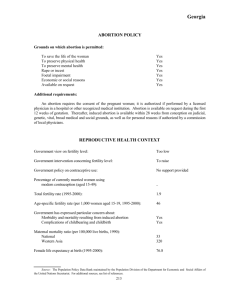Observations on the Post Abortion Syndrome
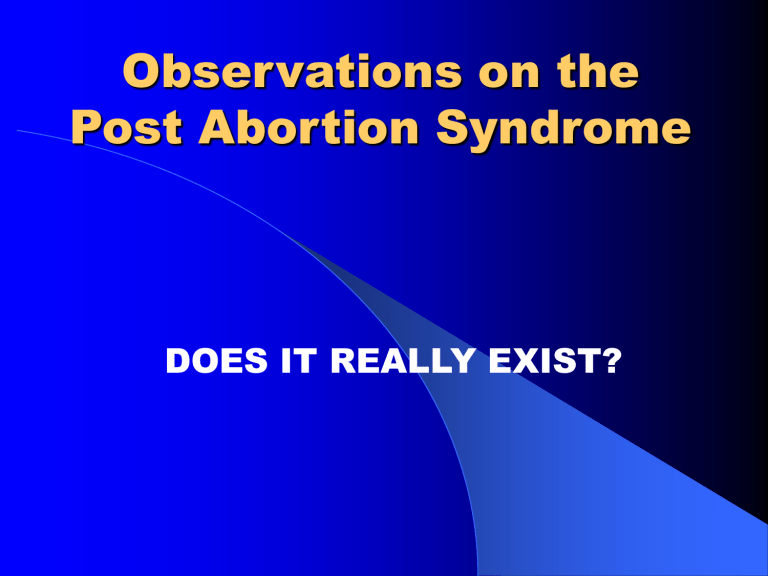
Observations on the
Post Abortion Syndrome
DOES IT REALLY EXIST?
Yes it does!
In spite of opinions that are published to the contrary. There is scientific evidence to document the validity of the diagnosis!
Published reports in refereed journals provide us wit the validity of the harmful effects of abortion. They are:
–
– physical and psychological
Physical Harm
10% of all abortions have unintended complications. They are:
– Infection occurs in 27% of the patients
–
–
–
3to 5% of all women become sterile and are more likely to have ectopic pregnancies
Cervical lacerations occur in 22% of eh women that later result in early deliveries or in miscarriages
Finally there is a 30% increased incidence of breast cancer in women who have first pregnancy abortions
Psychological Harm
There is only one positive emotional response to abortion and it is relief.
–
–
Relief from the embarrassment of having an unwanted child if the are single and
Relief from the potential duty of rearing an unwanted child
Psychological Harm
Even if there are positive effects 40 to 60% have negative emotional responses. These are:
– 55% have unremitting guilt
–
–
–
31% have regrets
33% have sleep disturbances
10% have serious psychiatric problems immediately afterwards
Psychological Harm
The greatest psychiatric harm occurs in women under 17 years of age.
Interestingly there is in many a period of denial of 5 to 7 years that is used to prevent negative feelings from rising in consciousness.
Psychological Harm
25% of all women who had an abortion eventually saw a psychiatrist for disturbing symptoms, vs 3% of women who delivered normally.
Among a large group of patients
–
–
46% had feelings of self hatred
49% used drugs and
– 39% either began to use alcohol or increased their use
Psychological harm
60% reported suicidal ideas
28% attempted suicide. 50% repeated the attempt
There is an incidence of completed suicide that is 6 times greater in women after abortion compared with those who delivered normally.
Psychological harm
What about men?
– It is reported that 75% of men who accompany their consorts to have an abortion have psychiatric sequelae.
– It is also true that siblings who know their mother had an abortion are also affected negatively. This affects their feelings of wantedness
Etiologic
Abortion can give rise to major depression serving as a precipitating factor
It can give rise to an existential depression that mimics major depression or dysthymic disorder
It can cause a person to abuse drugs and alcohol
It can be etiologic in Anorexia
Nervosa or bulimorexia
Case Illustrations
I have seen over 300 women who have had illnesses that were caused by abortions or to which abortion was a major contributor
I will present three of these
Cases
Case 1. This woman was a 43 year old wife of a physician who had been ill for three years. Her main complaint was an intractable depression that had not responded to treatment. Many medications had been tried and she only got partial relief. She was self referred to me for a second opinion.
Case 1
When my efforts at treatment using different meds and cognitive behavioral therapy did not result in relief I decided to review her history.
There were three major factors that seemed to be contributory. They were:
– 1. She had been rejected as a Bible study leader and her faith had been questioned
Case 1
–
–
2. She was under great pressure a mother and church leader
3 she had been in an auto accident with her son, but neither had been injured.
Her car was totaled, though, when she rolled it.
She detailed her history of thse factors, but it was not until she told me of the accident that I learned something new.
Case 1
She told me that she was taking her dyslexic son for treatment in a nearby city when she detailed how she rolled her
Volkswagen.
After she told me of the accident I asked her what she thought as the car rolled over.
Case 1
She said, “Now I will have killed both my sons!”
“But you have only one son,” I said.
“ Oh! I didn’t tell you. I had an abortion. I knew he was going to be a boy, and I was going to name him Christopher.”
Case 1
With this knowledge we used a spiritual intervention called
“Requiem Healing.” During the intervention she had profound emotional release and in one week was symptom free. Her meds were DC’d and she has remained well for over 28 years.
Case 2.
She was a 30+ year old woman who presented with intractable suicidal ruminations She had been hospitalized 5 times before for suicidal intent. I did all I could to relieve her depression using all the interventions I had available, and finally had to discharge her only slightly improved. Some months after she went home she committed suicide
Case 3
She was the unmarried daughter of a high official in the Malagasy
Lutheran Church. It is illustrative of a 20 year old woman who lived in
Madagascar.
I was in the country teaching primary care physicians basic psychiatric diagnosis and treatment.
I was asked to see her because she was displaying psychotic symptoms that had not responded to treatment by 1 of the countries 6 psychiatrists.
Treatment
I noted in case 1 that we used a intervention called “Requiem
Healing”
This was used in the other two cases as well with equally good results.
What is it?
Treatment Theory
Etiologically I have to say that one has to understand what happens when a woman becomes aware of her pregnancy. The child instantly becomes a part of her psychospiritually. The process was called by Bowlby (1982)
“attachment”
Treatment Theory
However, Julian Marias in his book
Metaphysical Anthropology called it
“installation.” The latter word indicates that it is in internal event.
He points out that all relationships involve installation. Those of a person with a spouse, a child, a friend and God.
Treatment Theory
We were all created with a radical need for relationships
– With a mate
–
–
–
With children
With friends
With God
Treatment Theory
Installation is complete and instantaneous in pregnancy
And in conversion with God
It is a process but becomes complete in time in the installation of a mate
And is gradual, but partial with a friend
Treatment Theory
When we install any of these people we live our lives for them.
Wherever we go they go too
The same is true for the person with whom we have a relationship
Treatment theory
The installation is a supernatural phenomenon
The installation is extremely strong and can be ended only with great mental work or by death
The mental work necessary for ending it is called grief
Treatment
If indeed the fetus is installed completely in the woman it is clear that she must grieve to end her relationship with the person Francke called the “Little ghost within.”
Since she is not allowed to grieve either by providers or her mate she has unresolved grief. It gives rise to the emotional symptoms we described earlier
Treatment
In the 1980’s Sack described the consequences of spontaneous abortions
–
–
–
1. Others do not know the woman is pregnant
2. The woman is embarrassed to tell people she has lost a baby
3. She has not usually identified the baby as a person
Treatment
4. She is not able to identify the baby as someone else
5.She rarely sees the baby she a has lost
6. There is no funeral so they can only fantasize about its sex, size and personality
Treatment
7. There is rarely recognition by the caregiver that a significant event has occurred
8. No one encourages her to grieve
9. There is no anticipatory grieving
Treatment
Several authors have commented on the need to resolve the grief, but few have offered any methodology to bring about the resolution
There is a 1944 study by
Lindemann that does offer help
Treatment
Lindemann has best described the role of religion in the process of grief resolution in his observations on the psychiatric aftermath of the
Coconut Grove fire.
Treatment
Fisher has utilized his work in a program for the resolution for grief in widows.
Kenneth McAll did the same for abortion
Treatment
I fist learned of this method in
1978 when I met Dr. McAll
He had observed that many women he treated who had abortions would be healed if a memorial service similar to the
Catholic Requiem Mass would be performed
Treatment
He collected an enormous number of cases beginning in
1950 of women who were healed using the technique of
“Requiem Healing.”
Among these in time were 441 cases of anorexia nervosa
Treatment
Since I was seeing more an more women who had abortions and were had developed disabling symptoms after the procedure I used his techniques with results similar to those he got.
Treatment
If I ascertain that the woman had an abortion or miscarriage as a determinant of her illness
I ascertain her level of spirituality
–
–
This is done by taking a spiritual history
If I think she is sufficiently spiritually sophisticated I ask if she had any notions as to the sex of the child an what she would have named him/her.
Treatment
I then get her to describe her feelings at the time of the abortion and afterward
I then try to help her understand the future she has with the child
This future is base on a hopeful biblical understanding of the afterlife.
Treatment
We then conduct a service that is a modified service used by
Methodists for the communion service
One can use the service for the dead in the book of common prayer
Treatment
This is modified to include in the prayer of confession the admission that the woman took the life of the child and is truly sorry for doing so
After the confession they commit the child to the Lord while visualizing their doing so
Treatment
In the visualizing of the release of the child, they see themselves standing at the threshold of God’s kingdom
In the background is the light of god’s presence
The patient then visualizes angels coming to the threshold and the mother passes the baby to the angels who carry it off into the light of God’s presence
Treatment
The mother tells the child goodbye. We end by repeating the
Lord’s prayer
If possible the Eucharist is celebrated at this time
The latter is not necessary for resolution of their grief
Comments
There has been at times enormous resistance to integrating faith with the practice of medicine or psychiatry
Even so over 80 medical schools have courses in spirituality and medicine
Comments
There has though been steady progress in bringing about his integration
Psychiatry has however not shown much interest, but instead had turned to using medications to treat everything
Comments
Managed health care has precipitated this change
So we now neglect the psychological and spiritual aspects of our patients problems and end up treating major mental illnesses
Comments
Residency training provides little instruction in anything besides the biological aspects of our patients illness
To handle these problems the patient is referred to counselors and psychologists who are ill prepared to treat them
Comments
Why?
– They like most psychiatrists
Deny the supernatural, have a limited worldview,
are not taught about the nature of man, do not understand that man is a spiritual being, and do not know how to use spiritual interventions,
William P. Wilson MD
Professor Emeritus of Psychiatry
Duke University Medical Center
Distinguished Professor of
Counseling
Carolina Evangelical Divinity School
www.InstChristiangrowth.org
wpwilson@netpath.net
